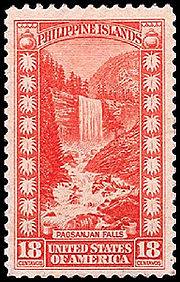
Postage stamp design error
Encyclopedia


Postage stamp design
Postage stamp design is the activity of graphic design as applied to postage stamps. Many thousands of designs have been created since a profile bust of Queen Victoria was adopted for the Penny Black in 1840; some considered very successful, othersless so....
phase of the postage stamp
Postage stamp
A postage stamp is a small piece of paper that is purchased and displayed on an item of mail as evidence of payment of postage. Typically, stamps are made from special paper, with a national designation and denomination on the face, and a gum adhesive on the reverse side...
production process. Design errors most commonly occur as minor mistakes, such as a missing letter in the binomial name of an organism depicted on the stamp, but some have been major gaffes, such as a map appearing to lay claim to another country's territory, or the depiction of the wrong person on the stamp.
A design error caught during the production process may disappear quietly, with copies of the error only getting into the public's hands via unscrupulous employees (these are therefore not considered "real" stamps). Design errors are often caught during the distribution process, when large numbers of postal workers are scrutinizing the new stamp; although officials may elect to withdraw all the stamps at that point, it is very difficult to retrieve every one of them, and in these instances a few may end up being sold and used. The exact circumstance are important, because once the stamp is sold to a customer, whether or not against the postal service's rules, it is considered to be legitimate.
The Legends of the West sheet was a particularly difficult case. Shortly before the release of this commemorative series (and after sheets had already been sent to post offices and found their way into collectors' hands), a claim was made that the image of Bill Pickett
Bill Pickett
Willie M. "Bill" Pickett was a cowboy and rodeo performer.Pickett was born in the Jenks-Branch community of Travis County, Texas. He was the second of 13 children born to Thomas Jefferson Pickett, a former slave, and Mary "Janie" Gilbert. Pickett had 4 brothers and 8 sisters...
used for his stamp's painting was actually an image of his brother Ben. The United States Postal Service decided to recall the stamps and re-issue them later with Pickett's stamp based on an image known with certainty to be him. The USPS sold the entire run of erroneous stamps at face value by lottery.
Somewhat rarer is a design error that is first noticed by a member of the public. This usually happens within a few days of the stamp first going on sale, usually ends up as the subject of newspaper articles, and has been known to cause a diplomatic breach.
The response of postal officials may include withdrawal of all the stamps, or simply the suspension of printing and distribution, pending revision and reprinting. If the stamps are withdrawn, then the ones already out there become instant rarities, as happened with the PRC's "All China is Red" stamp of 1968. The withdrawn stamps may be destroyed or overprint
Overprint
An overprint is an additional layer of text or graphics added to the face of a postage stamp or banknote after it has been printed. Post offices most often use overprints for internal administrative purposes such as accounting but they are also employed in public mail...
ed if the design can be repaired that way.
Design errors occurring during chaotic times such as revolutions will simply become a topic of discussion for future philatelists. Similarly for errors occurring in highly technical aspects, such as the spelling of a scientific name of a plant or animal, and may not be noticed during the stamp's period of use.
Some notable design errors
- Legends of the West, US 1993
- All China is Red, PRC 1968
- Pagsanjan Falls stampPagsanjan Falls stampThe Pagsanjan Falls stamp is a postage stamp issued on 3 May 1932, which is notable for having an error. It is part of a set of seven stamps showing places of interest and landmarks in the Philippines, at that time a United States territory...
, Philippines 1932 - Gronchi RosaGronchi RosaThe Gronchi Rosa is a rare Italian postage stamp design error. It was part of a 1961 issue for the voyage of president Giovanni Gronchi to three South American countries....
, Italy 1961 - Schubert/Schumann error, German Democratic Republic 1956
The largest run of an error on a postage stamp is the 2011 United States 'Statue of Liberty Forever Stamp
Forever Statue of Liberty Stamp
The United States Post Office issued the Statue of Liberty Forever stamp in December 2010. The stamp shows the replica of the Statue of Liberty in Las Vegas rather than the original Statue of Liberty in New York. The error was not noticed until March 2011. The error was identified by Sunipix, a...
'. The stamp shows the replica of the Statue of Liberty in Las Vegas rather than the original in New York. The stamp was released in December 2010 and the error was not noticed until March 2011 when it was was identified by Sunipix, a stock photo agency in Texas. Ten and a half billion of the error stamps were produced.

